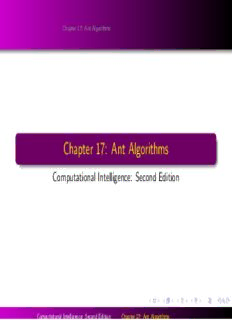
Preview Ant Algorithms
Chapter17:AntAlgorithms Chapter 17: Ant Algorithms Computational Intelligence: Second Edition ComputationalIntelligence:SecondEdition Chapter17:AntAlgorithms AboutAnts AntColonyOptimizationMeta-Heuristic Chapter17:AntAlgorithms CemeteryOrganizationandBroodCare DivisionofLabor AdvancedTopics Contents About Ants Ant Colony Optimization Meta-Heuristic Cemetery Organization and Brood Care Division of Labor Advanced Topics ComputationalIntelligence:SecondEdition Chapter17:AntAlgorithms AboutAnts AntColonyOptimizationMeta-Heuristic Chapter17:AntAlgorithms CemeteryOrganizationandBroodCare DivisionofLabor AdvancedTopics Some Facts Ants appeared on earth some 100 million years ago The total ant population is estimated at 1016 individuals [10] The total weight of ants is in the same order of magnitude as the total weight of human beings Most of these ants are social insects, living in colonies of 30 to millions of individuals Many studies of ant colonies have been done, to better understand the collective behaviors found in ant colonies: foraging behavior, division of labour, cemetery organization and brood care, and nest construction ComputationalIntelligence:SecondEdition Chapter17:AntAlgorithms AboutAnts AntColonyOptimizationMeta-Heuristic Chapter17:AntAlgorithms CemeteryOrganizationandBroodCare DivisionofLabor AdvancedTopics The First Pioneers Eug´ene Marais (1872-1936), one of the first to study termite colonies, published his work in The Soul of the Ant [12] Maurice Maeterlinck (1862–1949), published The Life of the White Ant [11], largely drawn from Marais’s articles (see the discussion in [12]) Pierre-Paul Grass´e [8] (1959) postulated on the mechanics of termite communication in studies of their nest construction behavior Grass´e determined that a form of indirect communication exists between individuals, which he termed stigmergy Deneubourg et al. [3] (1990) studied pheromonal communication as an example of stigmergy From these studies, Dorigo implemented the first algorithmic models of foraging behavior in 1992 [4] ComputationalIntelligence:SecondEdition Chapter17:AntAlgorithms AboutAnts AntColonyOptimizationMeta-Heuristic Chapter17:AntAlgorithms CemeteryOrganizationandBroodCare DivisionofLabor AdvancedTopics Foraging Behavior of Ants How do ants find the shortest path between their nest and food source, without any visible, central, active coordination mechanisms? Initial studies of foraging behavior showed: Initial random or chaotic activity pattern in the search for food When food source is located, activity patterns become more organized More and more ants follow the same path to the food source Auto-magically, most ants follow the same, shortest path. This emergent behavior is the result of a recruitement mechanism, via pheromone trail following ComputationalIntelligence:SecondEdition Chapter17:AntAlgorithms AboutAnts AntColonyOptimizationMeta-Heuristic Chapter17:AntAlgorithms CemeteryOrganizationandBroodCare DivisionofLabor AdvancedTopics Foraging Behavior of Ants (cont) Autocatalytic behavior – positive feedback: Forager ants lay pheromones along followed trails Paths with a larger pheromone concentration have a higher probability of being selected As more ants follow a specific trail, the desirability of that path is reinforced by more pheromone being deposited This attracts more ants to follow that path Stigmergy Indirect communication where ants modify their environment by laying pheromones to influence the behavior of other ants ComputationalIntelligence:SecondEdition Chapter17:AntAlgorithms AboutAnts AntColonyOptimizationMeta-Heuristic Chapter17:AntAlgorithms CemeteryOrganizationandBroodCare DivisionofLabor AdvancedTopics Foraging Behavior of Ants (cont) Bridge experiment (figure 17.1) Path A Nest Food Path B Probability of the next ant to choose path A: (c +n (t))α A P (t +1) = = 1−P (t +1) A (c +n (t))α+(c +n )α B A B n (t) and n (t) are the number of ants on paths A and B A B respectively at time step t c quantifies the degree of attraction of an unexplored branch α biases towards pheromone deposits in the decision process ComputationalIntelligence:SecondEdition Chapter17:AntAlgorithms AboutAnts AntColonyOptimizationMeta-Heuristic Chapter17:AntAlgorithms CemeteryOrganizationandBroodCare DivisionofLabor AdvancedTopics Foraging Behavior of Ants (cont) The larger the value of α, the higher the probability that the next ant will follow the path with a higher pheromone concentration The larger the value of c, the more pheromone deposits are required to make the choice of path non-random The decision rule: if U(0,1) ≤ P (t +1) then follow path A otherwise follow A path B ComputationalIntelligence:SecondEdition Chapter17:AntAlgorithms AboutAnts AntColonyOptimizationMeta-Heuristic Chapter17:AntAlgorithms CemeteryOrganizationandBroodCare DivisionofLabor AdvancedTopics Foraging Behavior of Ants (cont) Extended binary bridge (figure 17.2): Nest Nest Food Food (a) (b) Differential pathlength effect: The probability of selecting the shorter path increases with the length ratio between the two paths ComputationalIntelligence:SecondEdition Chapter17:AntAlgorithms AboutAnts AntColonyOptimizationMeta-Heuristic Chapter17:AntAlgorithms CemeteryOrganizationandBroodCare DivisionofLabor AdvancedTopics Foraging Behavior of Ants (cont) Each ant is a stimulus-response agent, following simple production rules (Algorithm 17.1): Let r ∼ U(0,1); for each potential path A do Calculate P using; A Sort P in decreasing order; A if r ≤ P then A Follow path A; Break; end end ComputationalIntelligence:SecondEdition Chapter17:AntAlgorithms
Description: